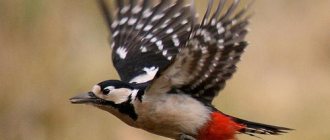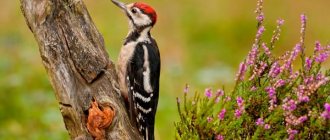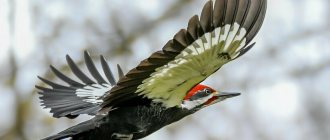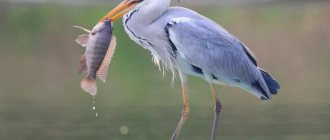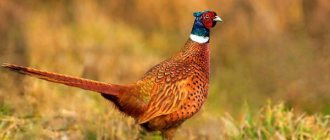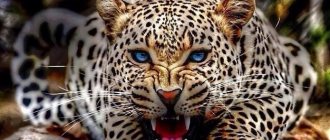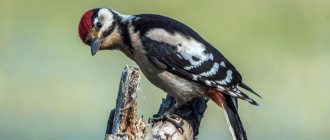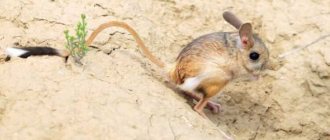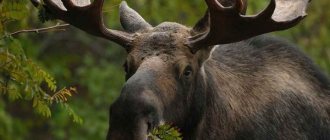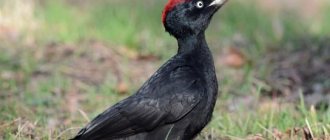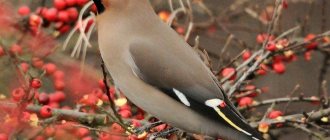Woodpecker nesting should be described in more detail. In the spring, almost all woodpeckers hollow out new hollows for nests. Before starting to build their permanent home, excited males scream and drum loudly.
The green woodpecker and the yellow woodpecker are especially noisy. Drumming plays the same role for woodpeckers as singing does for songbirds. It is characteristic of all our woodpeckers, from the large, almost raven-sized, woodpecker to the small Far Eastern lesser woodpecker. Only if the loud drum of the yellow woodpecker is heard throughout the entire forest, then the quiet trill of a small woodpecker can only be heard close up.
Birds use a dry, well-resonating branch as a “musical instrument” and, often knocking on it, produce a loud trill that merges into a single crack. Then they begin to hollow out the hollow, spending about a month on this work. In many species of woodpeckers, the male begins to peck at it, attracting the female with his work, loud screaming and drumming. If she responds to the gentleman’s call, she will finish finishing the hollow herself.
Fresh hollows in the spring are easy to detect by the wood dust that grows lighter under the tree, thrown out by woodpeckers when cleaning their homes. Naturally, the homes of different species of woodpeckers differ in size and in a number of other characteristics. The conversation will begin about how you can find out which woodpecker the found nest belongs to.
Origin of the species and description
Photo: Spotted Woodpecker
The spotted woodpecker is one of the most extraordinary representatives of the woodpecker family. This bird with a unique appearance densely inhabits deciduous, mixed forests. The lifestyle of most woodpeckers is sedentary. However, individuals living on the northern periphery can migrate to nearby regions. Not only severe frosts, but also unfavorable feeding conditions make birds nomads.
Interesting fact: The woodpecker family today has about two hundred and twenty different species. The size of the birds ranges from fifteen to fifty-three centimeters. Spotted woodpeckers are one of the most numerous species.
You can recognize the spotted woodpecker by its so-called red cap, located on the parietal part of the head. This species includes from fourteen to twenty-six races. The subspecies taxonomy of the bird has not yet been thoroughly studied, so the exact number of subspecies cannot be determined. Among the most famous subspecies of spotted woodpeckers are: great sharp-winged, yellow-breasted, brown-fronted, Malaysian, Arabian, middle and great spotted woodpeckers.
Interesting fact: Woodpeckers are noisy animals. They are capable of hitting a tree at a phenomenal speed - 20-25 times per second. This is twice the maximum speed of the machine gun.
Spotted woodpeckers, like other numerous members of the woodpecker family, play an important role in forest ecology. They rid forests of pests and help small birds acquire nests. Woodpeckers hollow out the thick bark of a tree, leaving hollows for tits and flycatchers.
Appearance and features
Photo: Spotted woodpecker bird
Woodpeckers of this species are medium or small in size. In size they can resemble the common thrush. The body length usually does not exceed twenty-seven centimeters. The wingspan is, on average, forty-five centimeters. The weight of the animal ranges from sixty to one hundred grams.
The most important external feature of the woodpecker is its bright color. The color of the feathers is dominated by black and white tones. The motley appearance of the animal is given by a bright red cap on its head and red (pink in some subspecies) undertail. The back and the rest of the head have a slight blue sheen. The underparts are usually white, sometimes with a brown tint. In general, color depends on the habitat.
Video: Spotted Woodpecker
The spotted woodpecker, like most other members of the family, has zygodactyl feet. He has three fingers pointing forward, one back. This structure of the paws allows the animal to easily and reliably grab onto tree trunks and confidently stay there in an upright position. Hard tail feathers also play an important role in this process. They also help to stay on the trunk when moving up.
Interesting fact: A distinctive feature of such birds is their long, sometimes barbed, tongue. In adults it can reach ten centimeters in length. With the help of such a tongue it is much easier to extract beetles and insects from the bark of trees.
Birds of this species have strong, large wings. However, they do not use them very often. Wings are used only for flying from one tree to another. The rest of the time, woodpeckers prefer to climb the trunk in search of food. A characteristic feature of birds is their voice. The song of pileated woodpeckers is quite short, vaguely reminiscent of a continuous drum roll. When in danger, it can make a loud cry.
General information
Each species of bird has some unique feature. The bald eagle has huge nests, the hummingbird has tiny size, the peacock has a gorgeous tail, and the great spotted woodpecker has chiseled trees. Fans of forest walks can hear its characteristic “knock-knock” from early morning until sunset. The woodpecker's blows on the trunk resemble drumming. Each time it lasts only 0.6 seconds, during which the bird manages to make up to 13 (according to other sources up to 23) strikes. If you hear these sounds, it means that Great Spotted Woodpeckers have entered mating season. When a bird takes a beetle out from under the bark, the sounds can be completely different.
Woodpeckers have been known to people for many centuries. They are even mentioned in myths and legends. So, it was this bird that helped the she-wolf feed Remus and Romulus, who became the founders of Rome.
In Europe during the Neolithic period there was a cult of the woodpecker. In the third century BC, forest "drummers" were highly revered by the Sabines. One of their genera was named woodpecker. Therefore, the bird was idolized and no harm was ever done to it.
Where does the spotted woodpecker live?
Photo: Great Spotted Woodpecker
The spotted woodpecker is distributed on various continents. It lives in Africa, Morocco, the Canary Islands, and Europe. In European territory it lives almost everywhere. The exceptions are some highland areas, Ireland, and the northern part of Scandinavia. This bird can also be found in Asia Minor, Sicily, Sardinia, the Caucasus, and Transcaucasia.
Woodpeckers live in large numbers in Scandinavia and Finland. There they can be found in areas with dense woody vegetation. This species is widely represented in Ukraine. Huge populations are found in the southern part of the state to the city of Dnieper. You won’t find such birds only in the steppe zones of Ukraine. Great spotted woodpeckers live in almost all regions of Russia and are found in the mountainous Crimea, Mongolia, and western China.
Spotted woodpeckers do not have very strict habitat requirements. They can adapt to any biotype. The only important point for them is the presence of trees. They settle in the northern taiga, on small wooded islands, in gardens and parks. These birds are not afraid of being close to people, so they build their nests even in the parks of densely populated cities.
Despite some plasticity in relation to biotypes, the bird population may not be distributed evenly. They often show preference for different types of forest. Individuals living in Africa often choose cedar, poplar, and olive forests for living. In Russia, the animal usually lives in deciduous forests. In Poland - in oak-hornbeam, alder-ash groves.
What does the spotted woodpecker eat?
Photo: Spotted Woodpecker
The diet of spotted woodpeckers depends on two factors:
- Season of the year;
- Habitat region.
In the warm season - from the beginning of spring to the end of summer, birds obtain food for themselves, preferably on the trunks of various trees, on the ground. They carefully inspect each tree. Begin inspection from the bottom of the trunk. They climb up the tree in a spiral, without missing a single centimeter of bark. During the inspection, the bird actively uses its long tongue, running it into the cracks. If the tongue detects food, then the powerful beak comes into play. It breaks the bark, from which the animal can easily get prey.
In spring and summer, the diet includes:
- Various beetles: borers, bark beetles, longhorn beetles, ground beetles, leaf beetles;
- Imago of butterflies;
- Aphids;
- Caterpillars;
- Ants;
- Crustaceans;
- Shellfish.
They can also eat gooseberries, currants, plums, raspberries, and cherries. In this case, the animals first remove the seeds from the berries. Berries are a favorite food of birds living in European territory. There, these animals often make massive raids on gardens. Sometimes woodpeckers feast on tree sap.
Interesting fact: The main method of obtaining food is chiselling. The process is quite intense and traumatic, but not for the woodpecker himself. His brain seems to be suspended inside the skull on strings, surrounded by liquid. All this significantly softens the blows.
In winter, it becomes more difficult for animals to get food in the wild. For this reason, most individuals move closer to humans. There they can find food for themselves in special feeders and even in garbage dumps. In the cold season, woodpeckers do not disdain carrion; they often attack the nests of small songbirds, eating their eggs or recently hatched chicks. Also in winter, various foods of plant origin are added to the bird’s diet. They eat oak, beech, and hornbeam seeds, and eat nuts, acorns, and almonds.
Nutrition
Woodpeckers' menu includes insects. They obtain them in a variety of ways. Those species that prefer to live in trees get their food from under their bark. The bird does this with extreme caution, trying to damage the tree itself as little as possible.
With a strong beak, the woodpecker makes a small hole in the bark, then with a very long tongue takes out the insect larva from there. It is worth noting that the length of a woodpecker's tongue is equal to the length of its several beaks. Its tongue has special spines with which the bird catches its prey.
How does a woodpecker understand where exactly it should make a hole? Everything is very simple. The bird has excellent hearing. A woodpecker hears the slightest rustle under the bark of a tree. Woodpeckers that live in the steppe or desert look for food for themselves exclusively on the surface of the earth.
Woodpeckers' favorite delicacies are beetles, caterpillars, larvae, butterflies, ants, and worms. In addition to all this animal food, they eat plant foods. Most often, woodpeckers living in cold regions resort to this type of food.
They completely replace the absence of insects with nuts, pine and spruce seeds. There is an acorn woodpecker whose favorite delicacy is acorns. There are species of these birds for which it is very important to drink the sap of a tree.
Features of character and lifestyle
Photo: Spotted Woodpecker in nature
Spotted woodpeckers spend their entire lives in forests. They settle in forests of various compositions, conditions, and ages. Hollows are built in trees with soft wood. Usually this is aspen, alder, birch. The construction of the hollow is done by the male. Rarely, birds can settle in hollows abandoned by other species of woodpeckers. The diet is varied, and in different seasons it is replenished with new items.
The spotted woodpecker is an extraordinary, noisy bird. She can spend a lot of time near human habitation. Even large cities are not afraid of her. Most of the adults lead a solitary lifestyle. They rarely form groups. The animal hunts for food during the day and usually “hunts” in a relatively small area. Each bird has its own feeding area. If a stranger flies onto him, a fight may occur.
Interesting fact: Before rushing into battle, the spotted woodpecker always warns its opponent. He takes a certain position, opens his beak, and the feathers on his head become ruffled. Sometimes this allows you to scare away a potential enemy.
Spotted woodpeckers are peaceful birds. They fly into neighboring areas extremely rarely, only during the period of active reproduction. However, if the flying bird does not leave the owner’s area, a fierce battle may begin. When fighting, birds inflict quite serious injuries on each other. Animals use their wings and beaks to protect and strike. Woodpeckers are usually not afraid of people. They simply climb higher into the tree and continue looking for food.
Development of chicks. Lifespan of birds
According to the methods of development of chicks, all birds can be divided into two categories: some are called brood birds, others are called chick birds. The chicks of brood birds immediately or very shortly after leaving the egg leave the nest and can move independently. They emerge from the nest with their eyes and ears open, wearing a well-developed downy plumage. This group includes those birds that stay primarily on the ground or near water, but not in trees: ducks, geese, rails, bustards, cranes, loons, grebes, gulls, waders, hazel grouses, flamingos, triplets. Young chicks emerge from the egg with poorly developed muscles of the limbs, bare or slightly pubescent, often blind and deaf. They do not yet have a constant body temperature, and in this respect they resemble lower vertebrates. These chicks are thus completely helpless and spend the first days or weeks of their lives in the nest until they develop plumage and are able to move independently.
We can say that the chicks of brood birds emerging from the eggs correspond in their development to the chicks of the period when the latter are ready to fly out of the nest. Nestling birds include, for example, passerines, woodpeckers, cuckoos, hoopoes, swifts, pigeons, rakshi, kingfishers, copepods (pelicans and cormorants), as well as raptors, owls and tubenoses. Young chicks have a very characteristic coloring of the mouth and its edges - usually bright (yellow or pink). Caring for the brood is also different in brood and nestling birds. In broodbirds, an adult bird, with young ones (in some species a male, in most - a female, less often part of the brood is with a male and part with a female, as is the case with grebes and cranes), leads the brood, protects it, covers it with its body when unfavorable weather occurs (cold, rain), it searches for and points out food to the chicks.
However, little ducklings immediately begin to find their own food on their own. In some waterfowl, in the first days of life, when tired, the chicks sit on the mother’s back, and grebes hold the chicks under their wings when swimming and even diving.
The relationship between parents and offspring is more complex in nestling birds. In cases where both sexes participate in incubation or when the male feeds the incubating female, both parents jointly feed the chicks, but the nature of their participation in feeding is not the same.
At first, in birds of prey, it is mainly the male who catches prey, and the female feeds the chicks, tearing the prey into pieces. When the chicks grow up and begin to tear the prey themselves, both parents bring them food. It has already been noted that feeding chicks requires a lot of effort from old birds. Feeding chicks with food occurs differently in different species. When insectivorous birds arrive at the nest, they give food to only one chick (with rare exceptions), while meat-eating and granivorous birds give food to the entire brood. The sequence and uniformity of feeding chicks in granivores is ensured by the movement of “well-fed” and “hungry” chicks in the nest.
Fed chicks usually move to the edge of the nest and defecate, raising their tail high; the hungry move to take their place in the middle of the tray. Adult birds clean the nest of all impurities (only pigeons and hoopoes do not do this) and warm the chicks, covering them with their bodies. Since overheating is no less dangerous for the chicks than cold, the parents shade the nest during the hours when direct rays of the sun fall on the brood; an adult bird stands over the nest and slightly opens its wings. Many predators shade their chicks with green tree branches. In nestling birds, the chicks usually leave the nest after they learn to fly.
Social structure and reproduction
Photo: Spotted woodpecker bird
Females and males of woodpeckers have practically no differences. The only factor by which they can be distinguished externally is variations in feather color. Male birds have a red nape, while females have a yellow or black nape. Spotted woodpeckers are monogamous. In Japan alone, several cases of polyandry have been reported.
The breeding season begins at the end of the first year of life of woodpeckers. Animals form pairs, after the end of the breeding season, most of them break up. Only a small number of couples continue to live together until the following spring. The mating season for birds begins at the end of winter. Mating activity may continue until mid-May. By May, the birds are already forming pairs and building “family” nests.
In general, the reproduction process can be divided into several stages:
- Acquaintance. Females and males get to know each other by combining their feeding areas. When meeting, males show themselves more actively - they shout, drum on branches, and attract attention in every possible way. Often, during mating games, birds begin to flutter through the air like butterflies. This game is called mating flight;
- Pairing. It is the mating flights that most often end in mating. The process is carried out on a horizontal branch and takes about six seconds. Mating is usually accompanied by loud calls;
- Laying, incubating eggs and caring for chicks. At one time, a female woodpecker lays about seven eggs. The eggs are white and their skin is shiny. Both parents incubate the eggs, but the male spends more time in the nest. The incubation process is quite short - thirteen days. The chicks hatch helpless, blind, with a good appetite. Until maturity, both parents provide their nutrition. Twenty days after birth, the chicks can learn to fly, and after another ten days they can independently obtain food.
Nesting is desirable
A hollow hollow hollowed out in the trunk of a large living aspen (45 cm in diameter) at a height of 7 m from the ground (scratches from the claws of the hind paws of a bear cub climbing the tree are visible on the bark)
Zhelna hollows out hollows in thick tall trees with a trunk diameter of about 45 cm. In the middle zone, most often in aspens, pines and birches. However, the choice of tree depends on the structure of its wood and the habitat of the birds. In the western regions, birds use beech, pine, spruce, alder, oak, ash, and poplar to build their homes.
In our area, yellowtails almost always hollow out a new hollow in the spring. Sometimes they make it in the same trunk, but above or below the old hollow. In the western parts of their range, where there are few trees suitable for nesting, black woodpeckers can use an old hollow several times.
Residential tree hollows were found at different heights, from 2.5 to 20 m. Chips are always visible under a fresh hollow, clearly visible against the dark background of last year’s rotted foliage. You notice it already from a distance of 10-15 m. The size of the chips is from 2.5 × 1 to 8 × 3 cm. They are clearly larger than under the nests of other woodpeckers.
The entrance often has the shape of an elongated quadrangle, occasionally a pentagonal shape, but more often I found hollows with an oval or almost round entrance hole. The width of the entrance is 6-7, height 9-14 cm. The hollow itself has the shape of a cylinder, it is 30-55 cm deep (in rare cases up to 1 m), and 15-20 cm wide. There is no bedding in it, with the exception of a small amount of remaining wood dust.
The first eggs laid can be found from the end of April to the end of the first ten days of May. They are regular in shape, white and glossy, with an average size of about 32x26 mm. There are 3-5 eggs in a clutch. They are incubated by both partners for 13 days. Hatching of chicks continues from mid to late May, and they fly out of the hollow 24-26 days after birth, most often in mid-June. The birds stay together for some time after this. I observed a brood of 4 chicks sitting all day on a one and a half meter rotten birch stump.
After the yellow season, clints, tawny owls, owls, whirling owls, starlings, redstarts, tree sparrows, pied flycatchers settle in its hollows, and in the west, in addition to those listed, jackdaws, hoopoees, rollers, goldeneyes, horned owls, and swifts.
During non-breeding times, the yellowtail spends the night in hollows, even in summer. However, I did not see this woodpecker hollowing out new holes for sleeping at night, as many of its other brothers do. Black woodpeckers climbed at night into old hollows with a hole darkened with time.
Natural enemies of spotted woodpeckers
Photo: Middle Spotted Woodpecker
The spotted woodpecker is not an easy prey for predators. It spends most of its time in trees, which is too high for foxes, wolves, bears and other large predators. Only occasionally can they be found on the ground. It is then that predators have every chance to catch and eat the bird. For this reason, today there is practically no information about predator attacks on pileated woodpeckers. Only ermine and marten can be called real ground enemies. These animals are more dexterous and cunning.
In temperate latitudes, woodpeckers can be attacked by birds of prey. Usually these are sparrowhawks or goshawks. Outside the forest, the main enemies of woodpeckers are peregrine falcons. They cleverly hunt them and attack them en masse. History knows of cases of complete destruction of the population of spotted woodpeckers by peregrine falcons.
Spotted woodpeckers are most vulnerable in the first days of life. While the parents fly in search of food, their nests are stolen by squirrels and dormouse. Occasionally, even ordinary starlings, which are much smaller in size, drive woodpeckers out of hollows. Also, the natural enemies of these animals are ticks, fleas, midges, wood lice, and some blood-sucking insects. They do not lead to immediate death of the bird, but significantly undermine its health.
Unintentionally, people also sometimes become the enemy of woodpeckers. It is people who engage in uncontrolled deforestation, destroy bird food, and pollute the air and soil. All this undoubtedly has a negative impact on the animal population.
Speech logical task
Option 1. Is the woodpecker a useful bird?
A father and little son walk through the forest, listen and take a closer look at forest life. A hazel grouse flew out from under my feet and even scared me. When a bird sings, you will listen. And suddenly... a familiar knock. Woodpecker! I worked on one tree, on another, on a third. The son goes to his father and asks: “How is this possible? They say that the woodpecker is a useful bird, but he has ruined so many trees.” (according to Yu. Dmitriev)
Option 2. Why did the living grove become dead?
Zhaleikin came to the birch grove. He hears someone knocking like an ax. Zhaleikin crept up and saw: a woodpecker sitting on a birch tree and pecking at it with all his might. Only chips fly. I felt sorry for the birch. - Shoo, you nasty bird! - Zhaleikin shouted. “You’ll ruin all the birches with your carrying!” And he threw a stick at the woodpecker. He drove the woodpecker away, but did not notice that the woodpecker was hollowing out a dry birch tree, clearing it of beetles, larvae and caterpillars. Bark beetles, tree beetles, and carpenter beetles have multiplied. The birch trees in the grove began to hurt and dry out. And Zhaleikin, you know, protects the grove from woodpeckers. Either with a stick at a woodpecker, or with a slingshot. There was a living, cheerful grove, but it became dead dead wood and fallen trees. (according to N. Sladkov)
What mistake did these boys make that they didn't know? Why was this boy named Zhaleikin? What will happen to the forest if woodpeckers disappear from it?
